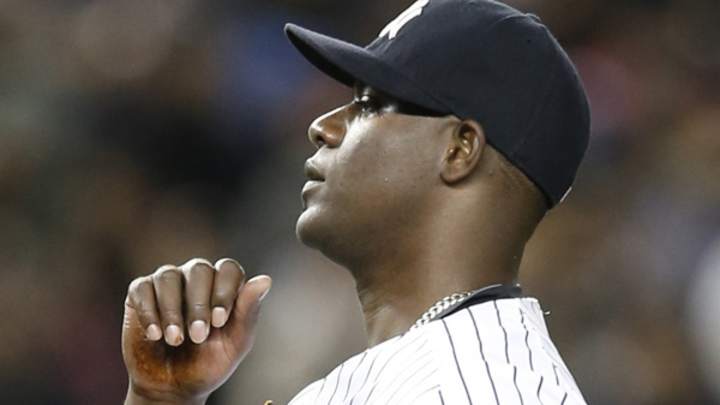Michael Pineda's pine-tar fracas shows sticky stuff not a real concern for MLB

Pine tar or some other substance was clearly visible on Michael Pineda's pitching hand Thursday. (Kathy Willens/AP)

Yankees righty Michael Pineda was brilliant against the Red Sox Thursday night, not allowing a hit until the fifth inning or a run until the seventh in a 4-1 New York win. He also appeared to be in blatant violation of Rule 8.02 (a)(4), which states, "The pitcher shall not apply a foreign substance of any kind to the ball," a violation of which is supposed to result in immediate ejection and suspension. Yet, despite the fact that the Red Sox were aware of what appeared to be pine tar or some other tacky, viscous substance on the heel of Pineda's pitching hand in a location and quantity that was easily seen by the television cameras, they did not complain, and Pineda was allowed to remain in the game.
Why? Because according to Red Sox manager John Farrell, a former major league pitcher and pitching coach, and Boston reliever Chris Capuano, who also pitched in Thursday night's game, Pineda's only real crime was being too obvious.
"With the cold weather, you’re looking to get a grip,” said Farrell. “I can’t say it’s uncommon, that guys would look to create a little bit of a grip. Typically, you’re not trying to be as blatant.”
“You’ve got to have a grip on the baseball and know where it’s going," said Capuano. "I just think you don’t want to flaunt it.”
Within the game, there is a widely accepted difference between a pitcher using a foreign substance to try to alter the way the ball flies through the air -- be it by scuffing or sliming the ball -- and using a foreign substance to improve his grip on the ball, particularly in cold weather (the first-pitch temperature in the Bronx on Thursday night was 54 degrees). Batters would rather a pitcher who throws in the mid-90s with movement, as Pineda was Thursday night, not have the ball slip out of his hand and toward their heads, and other pitchers, and their managers, coaches and teammates, want to have the same leeway.
There's even a loophole in the rulebook that, while it specifically omits Rule 8.02(a)(4), has clearly been extended to include it in practice:
Rules 8.02(a)(2) through 8.02(a)(6) Comment: If a pitcher violates either Rule 8.02(a)(2) [expetorate on the ball, either hand or his glove] or Rule 8.02(a)(3) [rub the ball on his glove, person or clothing] and, in the judgement of the umpire, the pitcher did not intend, by his act, to alter the characteristics of a pitched ball, then the umpire may, in his discretion, warn the pitcher in lieu of applying the penalty set for for violations of Rules 8.02(a)(2) through 8.02(a)(6). If the pitcher persists in violating either of those Rules, however, the umpire should then apply the penalty.
Pitchers don't use pine tar or other sticky substances to make the ball dance and dive. Sure, the extra grip may improve the rotation they get on their breaking pitches -- and Pineda's slider was indeed extra nasty Thursday night -- but it doesn't allow them to do something on a 54-degree night that they wouldn't be able to do without the sticky stuff in a game in 85-degree weather later in the season. No one has accused him of throwing a trick pitch, though the fact that such accusations were levied at Boston's Clay Buchholz last May might be yet another reason that the Red Sox opted not to complain about Pineda.
How common is the practice of a pitcher using a sticky substance to increase his grip in cold weather? So common that we were just having this conversation about another one of the Red Sox' pitchers in October during the World Series. Jon Lester started Game 1 for Boston at Fenway Park, a game with a first-pitch temperature of 49 degrees, and appeared to have a foreign substance on the thumb of his glove. No one complained. Lester dominated the Cardinals for 7 2/3 innings. No one complained. Controversy over the substance raged into the next day, but everyone within the game, both managers, the players, even MLB vice president Joe Torre, who surely had seen the television closeups of Lester's glove and incriminating footage of him clearly applying the substance to the first two fingers of his pitching hand, did their best to downplay and dismiss it.
“There were no complaints from the Cardinals or observations from the umpires about the baseball doing anything funny or irregular,” said Torre. “We will ask around, but without any complaint I don’t know what else you can say.”
What was the official response to Pineda's pine tar Thursday night?
"The Red Sox didn’t bring it to our attention," said umpire crew chief Brian O'Nora, "so there’s nothing we can do about it. If they bring it to our attention, then you’ve got to do something, but they didn’t bring it to our attention.”
O'Nora's being a bit misleading there. If a pitcher takes out a file and starts sawing away at the ball on the mound, the umpires don't have to wait for the other team to complain to act. Per Rule 8.02 (a), "The umpire shall be the sole judge of whether any portion of this rule has been violated." It's the subtext of Torre and O'Nora's comments that matters, and that subtext is that this is an accepted part of the game.
For his part, Pineda claimed the substance on his hand was a mixture of dirt and sweat. Farrell claimed that by the time he was made aware of it, Pineda had washed it off. Call it a massive cover-up if you want, but everyone who participated in Thursday night's game seems to be in agreement. Pineda's biggest crime was letting the fans and media notice what he was up to.
